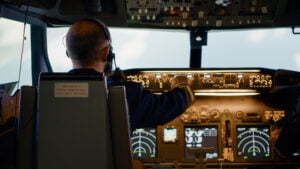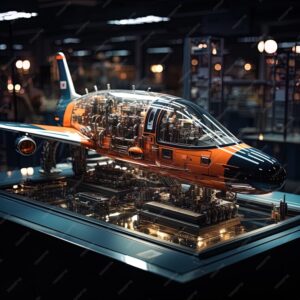Applications of ARINC 818: In the expansive realm of aerospace technology, where innovation propels us ever closer to the stars, one underlying element has emerged as a linchpin for communication and data transmission:
ARINC 818. This robust protocol, developed by Aeronautical Radio, Incorporated (ARINC), has revolutionized the way information flows within aircraft systems and beyond.
From military operations to commercial aviation, from space missions to automotive displays, ARINC 818 stands as a testament to the boundless possibilities of modern technology.
In this exploration, we embark on a journey to unravel the multifaceted applications of ARINC 818, delving into its diverse roles in shaping the future of aerospace and beyond.
As we navigate through its intricacies, we’ll discover how this protocol serves as a cornerstone for advanced mission systems, cockpit displays, and simulation technologies, and even extends its reach into emerging sectors like automotive and industrial control systems.
ARINC 818 not only facilitates seamless communication but also unlocks new realms of possibility, pushing the boundaries of what is achievable in the realms of flight, exploration, and innovation.
Join us as we venture beyond the horizon, into a world where ARINC 818 paves the way for unprecedented advancements, transforming the way we navigate the virtual sky.
Common Applications of ARINC 818:
Military sector of ARINC 818

Military applications of ARINC 818 technology represent a significant advancement in avionics systems, providing crucial capabilities for modern military aircraft.
These applications are diverse and encompass various components of military operations, ranging from navigation and targeting to situational awareness and mission planning.
One of the primary uses of ARINC 818 in military aircraft is in advanced cockpit displays and head-up displays (HUDs).
These displays provide pilots with critical information such as flight parameters, navigation data, weapon status, and sensor feeds in real time.
ARINC 818 enables high-speed data transfer between avionics components, ensuring that pilots receive accurate and up-to-date information to make informed decisions during missions.
Additionally, ARINC 818 plays a crucial role in targeting systems, allowing for the seamless integration of sensor data from various sources such as radar, infrared, and electro-optical sensors.
This integration enhances the aircraft’s ability to detect and track targets, enabling precise weapon delivery and minimizing collateral damage.
Moreover, ARINC 818 facilitates the implementation of advanced situational awareness technologies in military aircraft.
By integrating data from multiple sensors and sources, including terrain databases, threat databases, and friend-or-foe identification systems,
ARINC 818 enables pilots to maintain a comprehensive understanding of the operational environment, enhancing mission effectiveness and safety.
Furthermore, ARINC 818 is instrumental in the development of mission planning and debriefing systems for military aviation.
It allows for the efficient exchange of mission data between aircraft and ground-based command centers, enabling effective coordination and synchronization of mission objectives.
Additionally, ARINC 818 supports the recording and playback of mission data for post-mission analysis and training purposes.
Commercial Aviation of ARINC 818

In the bustling world of commercial aviation, where safety, efficiency, and passenger experience reign supreme, technologies like ARINC 818 have emerged as indispensable tools. This high-speed data transfer protocol, developed by Aeronautical Radio, Incorporated (ARINC), has revolutionized the way information is transmitted and displayed in modern cockpit environments.
At the heart of commercial aviation lies the cockpit display system (CDS), where critical flight information is presented to pilots in real time. ARINC 818 plays a pivotal role in this domain by facilitating the seamless transmission of data between avionics systems and display units. From flight parameters and navigation data to weather updates and system alerts, ARINC 818 ensures that pilots have access to the information they need to make informed decisions throughout the flight.
One of the key advantages of ARINC 818 is its ability to support high-resolution displays, allowing for crisp, clear visuals that enhance situational awareness and readability. This is particularly crucial during adverse weather conditions or low-visibility scenarios, where pilots rely heavily on their cockpit displays to navigate safely.
Moreover, ARINC 818 offers robust error detection and correction mechanisms, ensuring the integrity and reliability of data transmission even in challenging environments. This is paramount in commercial aviation, where the stakes are high, and any communication errors could have serious implications for flight safety.
In addition to its role in cockpit displays, ARINC 818 is also utilized in other avionics systems onboard commercial aircraft. For example, it is employed in head-up displays (HUDs), which project critical flight information onto the pilot’s field of view, allowing for heads-up operation without diverting attention from the outside environment.
Furthermore, ARINC 818 supports multi-function displays (MFDs) and electronic flight bags (EFBs), which provide pilots with a comprehensive suite of tools and resources for flight planning, performance monitoring, and documentation management.
Simulation and Training of ARINC 818

Simulation and training are critical components of aviation education and proficiency maintenance. ARINC 818, with its robust data transmission capabilities, has found significant application in this domain, revolutionizing how pilots and aviation personnel are trained in both civilian and military contexts.
One of the primary uses of ARINC 818 in simulation and training is in flight simulators. These simulators aim to replicate real-world flight scenarios with utmost accuracy, providing pilots with a safe and immersive environment to practice various maneuvers, procedures, and emergency responses. ARINC 818 enables high-speed transmission of data between the simulation system and the cockpit displays, ensuring that the simulated environment remains responsive and realistic.
In military training, ARINC 818 is particularly valuable for its ability to support complex mission simulations. From combat scenarios to aerial refueling operations, military pilots rely on advanced simulators equipped with ARINC 818 technology to hone their skills and tactical decision-making in a simulated battlefield environment. The seamless data transmission facilitated by ARINC 818 enhances the fidelity of these simulations, allowing trainees to experience highly realistic scenarios.
Moreover, ARINC 818 contributes to the development of training systems for specific aircraft platforms. By integrating the protocol into training devices such as cockpit mock-ups and procedural trainers, aviation organizations can ensure that pilots are proficient in operating the avionics systems of particular aircraft models. This targeted training approach enhances safety and operational efficiency by familiarizing pilots with the specific cockpit layouts and functionalities they will encounter in their respective aircraft.
Beyond pilot training, ARINC 818 is also utilized in training programs for maintenance technicians and ground support personnel. Simulation systems equipped with ARINC 818 can replicate various aircraft systems and avionics components, allowing technicians to practice troubleshooting procedures, maintenance tasks, and system diagnostics in a controlled environment. This hands-on training approach helps improve maintenance efficiency and reduces the risk of errors during real-world operations.
As technology continues to evolve, the integration of ARINC 818 in simulation and training systems is expected to advance further. Future developments may include enhanced virtual reality (VR) and augmented reality (AR) capabilities, providing even more immersive training experiences for aviation personnel. Additionally, ongoing efforts to standardize and optimize ARINC 818 protocols will ensure compatibility and interoperability across a wide range of simulation and training platforms, further enhancing the effectiveness and versatility of these systems.
Space Applications of ARINC 818

In the vast expanse of space, where communication and data transmission are paramount for mission success, ARINC 818 emerges as a crucial technology driving advancements in space applications. With its robustness, high-speed data transfer capabilities, and reliability, ARINC 818 has found diverse applications in space missions and satellite communication systems.
One of the primary areas where ARINC 818 shines is in spacecraft displays and avionics. Modern spacecraft are equipped with sophisticated display systems that provide critical information to astronauts and mission controllers. ARINC 818 facilitates the transmission of high-resolution imagery, telemetry data, and real-time video feeds from various sensors and cameras aboard the spacecraft. This enables astronauts to monitor mission-critical parameters, navigate through space, and perform complex maneuvers with precision.
Moreover, ARINC 818 plays a pivotal role in satellite communication systems. Satellites orbiting the Earth serve a multitude of purposes, including telecommunications, Earth observation, navigation, and scientific research. ARINC 818 enables seamless communication between ground stations and satellites, facilitating the transmission of commands, telemetry data, and payload information. The high-speed data transfer capabilities of ARINC 818 ensure timely and reliable communication, essential for coordinating satellite operations and maximizing mission efficiency.
Furthermore, ARINC 818 contributes to space exploration missions by supporting advanced visualization systems and virtual reality environments. Mission planners and scientists rely on immersive displays powered by ARINC 818 to analyze planetary surfaces, simulate spacecraft trajectories, and plan intricate maneuvers such as orbital rendezvous and landing operations. These visualization tools enhance situational awareness and decision-making, enabling mission teams to navigate through the complexities of space exploration with confidence.
Automotive and Industrial Applications

In recent years, the utilization of ARINC 818 has extended beyond its traditional aerospace applications into the automotive and industrial sectors, showcasing its versatility and adaptability across various industries. Let’s delve into how this advanced technology is making waves in automotive and industrial applications:
Automotive Displays: One notable application of ARINC 818 in the automotive industry is in the development of advanced vehicle displays. ARINC 818’s high-speed data transmission capabilities enable the seamless integration of sophisticated infotainment systems, digital instrument clusters, and heads-up displays (HUDs) within vehicles. These displays not only enhance the driving experience by providing real-time navigation, entertainment, and vehicle information but also contribute to improved safety and driver awareness.
Augmented Reality (AR) in Automotive: ARINC 818 serves as a backbone for implementing augmented reality features in automotive applications. By overlaying digital information onto the real-world environment, AR-enabled systems powered by ARINC 818 can enhance driver assistance systems, such as lane departure warnings, collision avoidance, and parking assistance. This technology offers drivers enhanced situational awareness, leading to safer and more efficient driving experiences.
Industrial Control Systems: In industrial settings, ARINC 818 plays a crucial role in powering advanced control and monitoring systems. By enabling high-speed data transfer and real-time communication, ARINC 818 facilitates the integration of complex industrial automation solutions, including supervisory control and data acquisition (SCADA) systems, robotics, and manufacturing processes. These systems benefit from the reliability and efficiency offered by ARINC 818, resulting in improved productivity, operational efficiency, and maintenance procedures.
Diagnostic and Maintenance Tools: ARINC 818 technology is also leveraged in the development of diagnostic and maintenance tools for automotive and industrial equipment. By providing seamless connectivity and data exchange between onboard systems and external diagnostic devices, ARINC 818 simplifies the troubleshooting and maintenance processes. This ensures timely identification of issues, reduces downtime, and enhances the overall reliability of vehicles and industrial machinery.
Future Directions: As automotive and industrial technologies continue to evolve, the role of ARINC 818 is expected to expand further. Future advancements may include the integration of augmented reality features in industrial maintenance procedures, the development of autonomous vehicle systems powered by ARINC 818, and the implementation of advanced predictive analytics for proactive maintenance and performance optimization.
Conclusion
In conclusion, the integration of ARINC 818 technology into automotive and industrial applications signifies a significant step forward in the evolution of these industries. With its high-speed data transmission capabilities and robust communication protocols, ARINC 818 enables the development of advanced vehicle displays, augmented reality features, and industrial control systems that enhance safety, efficiency, and productivity.
The adoption of ARINC 818 in automotive displays not only transforms the driving experience with intuitive infotainment systems and augmented reality features but also contributes to improved driver awareness and safety on the road. In industrial settings, ARINC 818 facilitates the integration of sophisticated control and monitoring systems, streamlining manufacturing processes, and enabling predictive maintenance procedures.
Looking ahead, the future of ARINC 818 in automotive and industrial applications is promising. As technology continues to advance, we can anticipate further innovations, such as the integration of augmented reality in maintenance procedures, the development of autonomous vehicle systems, and the implementation of advanced predictive analytics for optimizing performance and efficiency.
Overall, ARINC 818 is revolutionizing the automotive and industrial sectors, driving innovation, and paving the way for a future of interconnected, intelligent systems. Its versatility, reliability, and adaptability make it a crucial component in shaping the next generation of vehicles, machinery, and industrial processes, ultimately improving the lives of consumers and enhancing the competitiveness of businesses in a rapidly evolving technological landscape.






